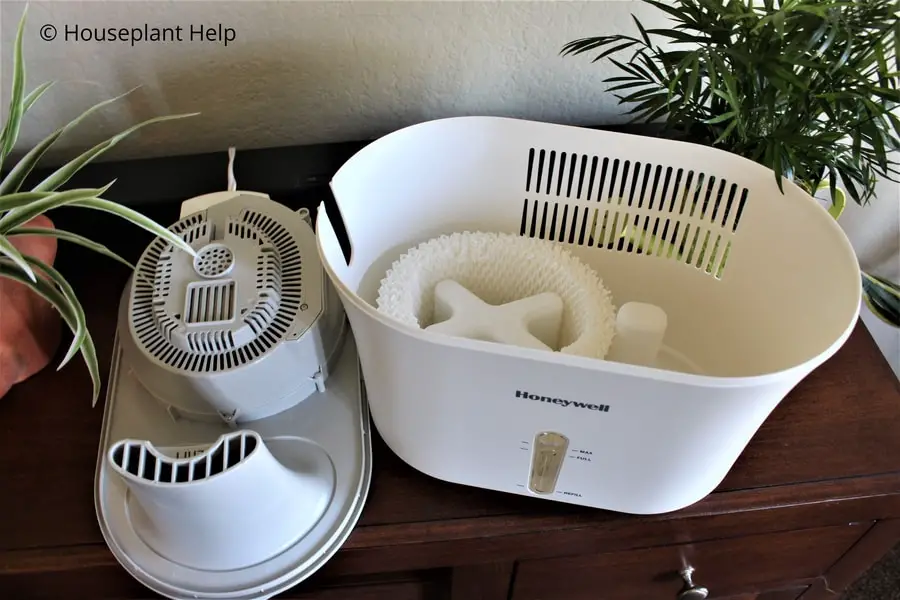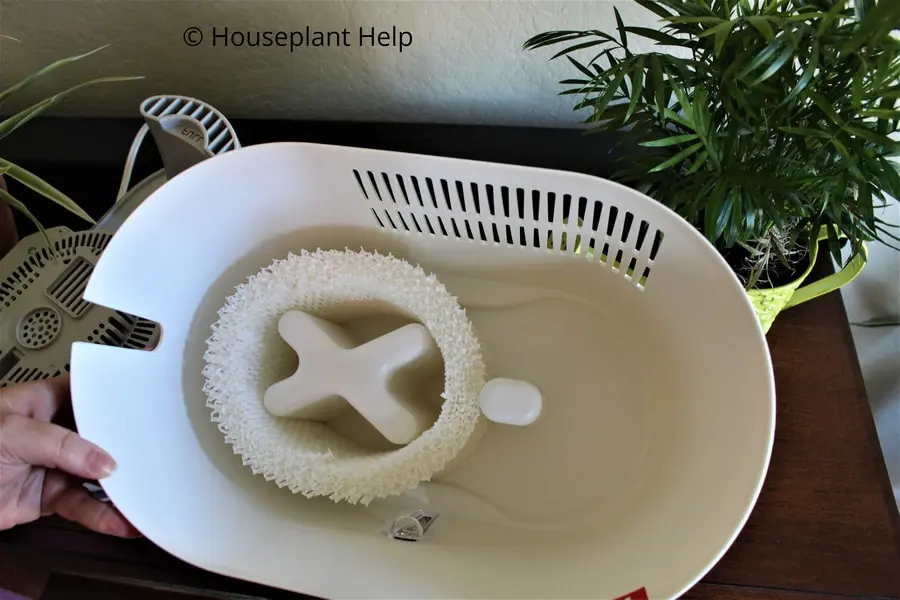Disclaimer: Some of the links below may be affiliate links. If you click through and make a purchase, I will earn a commission at no additional cost to you.

A humidifier is necessary for growing houseplants unless you live in a very humid area and don’t have central heat and air. Most people’s homes have very dry air and most houseplants are tropical with high humidity requirements. This is one of the most common reasons indoor gardens fail.
We live in the high desert, and without a humidifier, our houseplants just would not thrive. Over the years, I’ve tried many different brands and types of humidifiers. The best one by far is the Honeywell Easy to Care Cool Mist Humidifier HCM-710.
According to other reviews I’ve read, the new model has a quieter fan and the reservoir stays full longer. Otherwise, the features are mostly the same! CLICK HERE to see the Honeywell Cool Moisture Humidifier (next generation).
Why I Love the Honeywell Easy Care Cool Mist
When compared to other similar humidifiers, this one wins almost every time. It’s affordable, easy to use, and best of all – easy to clean. Here are all the reasons why I recommend this model:
- Reasonable Price – The Honeywell HCM-710 is reasonably priced – not top of the line but not cheap either. You can check the current price on Amazon to see for yourself. It’s a worthwhile investment in your houseplant hobby, but it won’t hurt your pocketbook too much.
- Easy to Clean – If you’ve ever had an ultrasonic humidifier, you’ll know what a pain they are to clean. This model is just the opposite. You can open the reservoir and wipe it out whenever you need to. It’s simply constructed, making it easy to care for (just like the name says).
- No Mineral Dust – I know this sounds strange if you’ve never used a humidifier. But most “mist” types leave behind a white dust on furniture and surfaces near the unit. This is due to the minerals in your water. I’ve had a humidifier completely ruin a nearby wooden dresser. The Honeywell HCM-710 DOES NOT cause this problem because of its amazing filter and invisible mist.
- Long Lasting Humidity – It’s easy to fill and lasts 36 hours per filling. Pour the water directly into the top of the unit – it holds up to 1 gallon – and you don’t need to fill it again for a day and a half if you run it constantly on the lowest setting. I usually top mine off every morning as I water and tend to my plants. It keeps the humidity levels perfect for an indoor garden.
- Inexpensive Upkeep – With other types of humidifiers, it’s basically a requirement to purchase expensive tank cleaning cartridges. While you can use them with the Honeywell HCM-710, you don’t need to due to its smart design that makes cleaning easy. The only upkeep expense you’ll have is the filters. These need to be changed every 2-3 months and cost $10 – $15.

Features to Look for in a Quality Houseplant Humidifier
Although any humidifier is better than none for your houseplants, I wouldn’t recommend just buying the cheapest one you can find. The misting ultrasonic models are difficult to clean, leave mineral dust all over your furniture, and require frequent fill-ups and expensive supplies (like tank cleaning tablets).
Here’s what I recommend you look for in a good quality humidifier that will give you years of service and keep your houseplants healthy:
- Wicking type – Like the Honeywell HCM-710 that I love so much, wicking humidifiers are typically easier to clean, easier to fill, and provide long-lasting humidity with less frequent fill-ups. Plus, you don’t need to buy tank cleaning tablets.
- Invisible Mist – If you can see the mist coming out of the humidifier, chances are it’s using too much water and it’s going to leave residue behind on your furniture. Look for a wicking filter with invisible mist, especially if it will be placed very near your plants.
- Cleanable Surfaces – Make sure that ALL surfaces – inside and out – can be reached and cleaned. Ultrasonic models often have reservoirs that cannot be cleaned by hand. This leads to mold and residue building up in the bottom – leading to an unhealthy environment. Look for a model that ensures you can easily clean the entire inside yourself.

Getting the Best Deal on Your Humidifier
As with any product, I recommend looking around online and comparing prices before you buy. We bought our Honeywell HCM-710 (pictured above) on Amazon because it was the best price we could find at the time. However, you never know when that might change.
You can also check your local Walmart, home improvement stores, etc. When we bought ours online, it also came with a 3-year warranty at no additional cost. Walmart often charges extra for warranties on electronics, so take that into consideration too.
If you’re strapped for cash, Amazon also has slightly used and new models from alternative sellers you can buy for less. I’d recommend buying the new version with the warranty if possible. But like I said before – any humidifier is better than none for keeping your houseplants healthy.
Why Humidifiers are Important for Houseplants
One of the primary causes of houseplant failure – and I found this out the hard way – is dry indoor air. The reason most houseplants can live indoors in lower light conditions is because they originate from a tropical climate – where the air is very humid.
In our modern homes with forced (central) air, moisture is very low or non-existent. Houseplants need a humidity level between 40 and 60 percent or more to really perform well.
It’s possible to keep humidity near your plants higher by placing them on top of trays filled with pebbles and water or misting them frequently. But this becomes difficult as your collection of plants grows. (And if you’re anything like me, you just can’t seem to stop acquiring more plants once you get started.)
A humidifier keeps the required moisture in the air with very little extra effort. You just fill it once every day or so and change the filter once every couple of months. It does all the rest of the work for you.
Our plants have never been healthier or more beautiful since we started using a humidifier. I highly recommend houseplant lovers buy at least one using the guidelines above and try it out. You’ll never go back to misting by hand or filling pebble trays!
